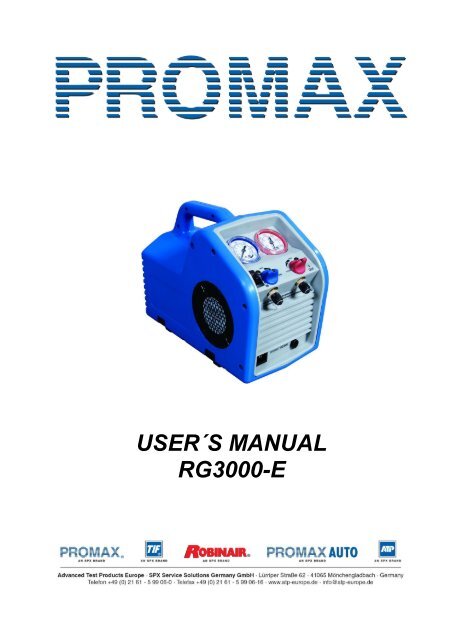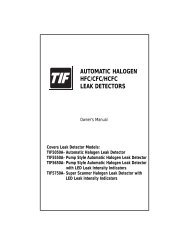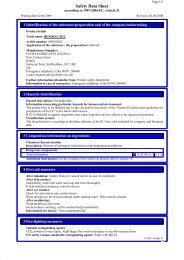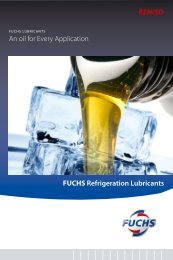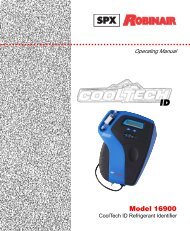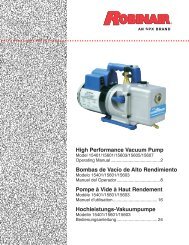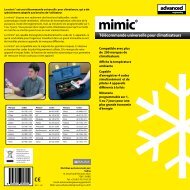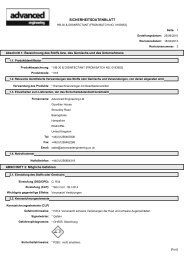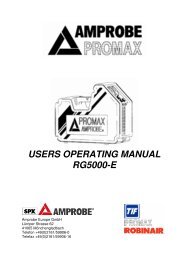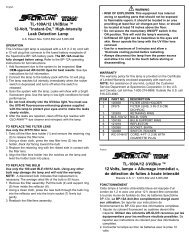USER´S MANUAL RG3000-E - Advanced Engineering
USER´S MANUAL RG3000-E - Advanced Engineering
USER´S MANUAL RG3000-E - Advanced Engineering
You also want an ePaper? Increase the reach of your titles
YUMPU automatically turns print PDFs into web optimized ePapers that Google loves.
USER´S <strong>MANUAL</strong><strong>RG3000</strong>-E
<strong>Advanced</strong> Test Products Europe<strong>RG3000</strong>-ETABLE OF CONTENTSI) Safety precautionsA) The safe way is the only way! 1B) Refrigerant gas recovery & containment 2II) Important general information 3III)Operating proceduresA) Operating your <strong>RG3000</strong>-E 4-6B) Set-up procedures 7-9C) Purging the non-condensable gases 10IV)DiagramsA) Parts list 11B) Refrigerant flow diagram 12C) Wiring diagram 13V) Automatic safety pressure switch 14VI) Care and maintenance 15VII) Technical data 16VIII) Helpful hints 17-19IX) Troubleshooting 20Design specifications and material are subject to change without notice. REV2 82011ASThis manual may not be reproduced in any way, shape or form without express writen consent of<strong>Advanced</strong> Test Products Europe.
<strong>Advanced</strong> Test Products Europe<strong>RG3000</strong>-ETHE SAFE WAY IS THE ONLY WAY!NOTE! If you are not a qualified refrigerant service technician,do not use this equipment1. The technician should always wear goggles and gloves when working onrefrigeration systems.2. Be sure that any room where you are working is thoroughly ventilated, especially ifa leak is suspected. Refrigerant vapor is hazardous to your health and can causedeath.3. Always think before acting. Familiarity breeds carelessness and carelessnes scanbe harmful to your health or, worse, result in death.4. Read the Material Safety Data Sheets (MSDS) on all compounds with which youare likely to come in contact. Read MSDS on refrigerant and refrigerant oil. ObtainMSDS sheets from your refrigerant supplier.5. Never use oxygen when testing for leaks. Any oil in contact with oxygen underpressure will form an explosive mixture.6. Refrigerant systems are generally electrically driven and controlled. Be sure todisconnect the unit from the power source before servicing it.7. Always store refrigerant containers in a cool, dry place.8. Always open service and cylinder valves slowly. This allows quick control of the flowof gasses if there is any danger. Once it is determined that there is no danger, thevalves may be opened fully.9. Do not mix refrigerant in a system, a tank or anywhere else. Each type of refrigerantmust have its own tank, filters, etc.10. If moisture enters the refrigerant system, it is likely to cause considerable damage.Keep everything connected with the refrigeration system thoroughly dry and clean.11. To reduce the risk of fire, avoid the use of extension cords as they may overheat.Ifyou must use an extension cord it should be a minimum of 12 AWG and not longerthan 5m.This equipment should be used in locations with mechanical ventilation providing atleast four air changes per hour, or the equipment should be located at least 45cm(18”) above the floor. Do not use this equipment in the vicinity of spilled or opencontainers of gasoline or any other flammable liquid.- 1 -
<strong>Advanced</strong> Test Products Europe<strong>RG3000</strong>-EREFRIGERANT GASRECOVERY & CONTAINMENTSafety comes first. Read all safety information for the safe handling of refrigerantincluding the Material Safety Data Sheet provided by your refrigerant supplier. Neveroperate unit in an explosive environment. Wear safety glasses and protective gloves.Work area must be well ventilated. This unit should only be operated by a qualifiedtechnician.*** CAUTION: REFRIGERANT STORAGE CONTAINERS ***Use only approved cylinders with a minimum of 41 bar working pressure that meet thecurrent regulations.NOTE: Recovery cylinders are designed for different pressures. Do not exceed theworking pressure of each cylinder.Safety codes recommend that closed tanks not be filled over 80% of volume with liquid.The remaining 20% is called head pressure room.NEVER TRANSPORT AN OVERFILLED CYLINDERRefrigerant expands when it gets warm and may cause a tank to explode if overfilled.CYLINDER TEMP. 16 °C 21 °C 38 °C 54 °C 66 °CSTARTING WITHCYLINDER 80%FULL BY VOLUMESPACE OCCUPIEDBY LIQUID80 % 81% 83% 90% 94%STARTING WITHCYLINDER 90%FULL BY VOLUMESPACE OCCUPIEDBY LIQUID90% 92% 96% 100%- 2 -
<strong>Advanced</strong> Test Products Europe<strong>RG3000</strong>-EIMPORTANTGENERAL INFORMATIONBefore operating the <strong>RG3000</strong>-E recovery unit, read the following:1. Storage cylinders sometimes have valves that are not properly seated whenmanufactured. Keeping caps on these valves will guard against refrigerant leakage.2. Always operate the unit on a flat level surface.3. Your <strong>RG3000</strong>-E has one internal pressure shut off switch. If the pressure inside thesystem should go above 38,5 bar (550 psi), the system will automatically shut itselfoff.CAUTIONThe 38,5 bar (550 psi) switch does not prevent tank overfill. If your system shutsoff on high pressure and is connected to your tank, you may have overfilled yourtank and created a very dangerous situation! Take immediate measures to relieveany high pressure and/or tank overfill.4. WARNING! Never overfill storage tanks. Overfilling may cause tanks to explode.5. A scale must be used to avoid overfilling the storage tank.6. Tanks and filters should be used for one refrigerant only. Before using a tankpreviously used for another refrigerant, completely empty the tank, evacuate it,purge the tank using dry nitrogen, and re-evacuate it.7. Special care should be taken when recovering from a burned-out system. Use twohigh acid capacity filters, in series. Alco type EK-162-F or Sporlan type C-162-F arerecommended.8. When you have finished recovering from the system, flush your <strong>RG3000</strong>-E with asmall amount of refrigerant oil and a small amount of clean refrigerant to purge offany foreign substances left in the unit.9. Always empty refrigerant from the unit into a storage tank; see Purge/AutoEvacuate procedure. Liquid refrigerant left in the condenser may expand, causingdamage to components.- 3 -
<strong>Advanced</strong> Test Products Europe<strong>RG3000</strong>-EOPERATING YOUR <strong>RG3000</strong>-EConnect your <strong>RG3000</strong>-E to a 230 V outlet and close both valves on the <strong>RG3000</strong>-E.Open the valves to the cylinder and system and make sure no air is in the hoses, onlyclean refrigerant. Open the outlet valve on the unit .Switch the main power switch to theON position. The fan and compressor will start running. Slowly open the inlet valve onthe unit and the refrigerant will start to move.OPERATING PROCEDURESNORMAL RECOVERYPURGE / AUTO EVACUATENOTE:To change from Recovery mode to Purge:If available, close the valve from the system to the inlet hose and wait untillthe LP gauge shows 0,1 bar. Then close the Inlet valve of the <strong>RG3000</strong>-E.Turn the unit off after the unit goes in to vacuum and switch off the <strong>RG3000</strong>-E. Close the outlet valve of the <strong>RG3000</strong>-E and close the valve on thecylinder.- 4 -
<strong>Advanced</strong> Test Products Europe<strong>RG3000</strong>-EOPERATING YOUR <strong>RG3000</strong>-EProcedure for Normal System Recovery1 Inspect the <strong>RG3000</strong>-E thoroughly to insure that it is in good operating condition.2 Make sure all connections are correct and tight (see diagram on page 8)3 Open the liquid valve of the recovery cylinder (always open valves slowly to checkhoses and connections for leaks).4 Open the outlet valve of the <strong>RG3000</strong>-E.5 Open the liquid valve on the manifold gauge set; opening the liquid valve willremove the liquid from the system first, greatly reducing the recovery time (after theliquid has been removed, open the manifold vapor valve to finish evacuating thesystem).6 Connect your <strong>RG3000</strong>-E to a 230 V outlet.7 Switch the main power switch to the ON position. You should hear thefan and compressor running.8 Slowly open the inlet valve on the <strong>RG3000</strong>-E.a) If the compressor starts to knock, slowly throttle back the inlet valveuntil the knocking stops.b) If the inlet valve was throttled back, it should be fully opened once theliquid has been removed from the system (the manifold vapor valveshould also be opened at this time).9 Run the unit until minimum required vacuum is achieved.a) Close the manifold vapor and liquid valves.b) Close the <strong>RG3000</strong>-E inlet valve.c) Shut unit off and proceed with the Purge procedure on the next page.10 Always purge the <strong>RG3000</strong>-E after each use. Failure to purge the remainingrefrigerant from the <strong>RG3000</strong>-E could result in the acidic degradation of internalcomponents, ultimately causing premature failure of the unit.CAUTIONWhen pumping liquid, do not allow the <strong>RG3000</strong>-E to operate with the inlet valvetoo far open, causing the compressor to knock. Doing so may damage thecompressor.- 5 -
<strong>Advanced</strong> Test Products Europe<strong>RG3000</strong>-EOPERATING YOUR <strong>RG3000</strong>-EProcedure for Purging Remaining Refrigerant From the <strong>RG3000</strong>-E1. Close the valves of the system being serviced that are connected to the inletvalve of the <strong>RG3000</strong>-E.2. Close the inlet valve on the <strong>RG3000</strong>-E. The outlet valve should remain open.3. Run the unit until desired vacuum is achieved.4. Turn the <strong>RG3000</strong>-E off.5. Close the valves on the recovery tank and the outlet valve on the <strong>RG3000</strong>-E.6. Disconnect and store all hoses.7. Replace the in-line filter on your <strong>RG3000</strong>-E after each time excessive contaminantis encountered.Important NoteWe strongly recommend the use of Robinair hoses with Quick Seals to avoid wastingrefrigerant because of their unique reverseable, built-in, check valve.RA69060A - set of 3 hoses wit Quick Seals Red, Yellow and Blue; 152cm long.- 6 -
<strong>Advanced</strong> Test Products Europe<strong>RG3000</strong>-E<strong>RG3000</strong>-E REFRIGERANT RECOVERYADDITIONAL INFORMATIONTo achieve the deepest final vacuum, use the tank cooling method to lower the headpressure on the recovery tank. Repeat as necessary to achieve the desired vacuumlevel.NOTE: If there is no liquid in the recovery tank, then the cooling method will not work. Inthis case, use an empty tank that has been fully evacuated to achieve the final vacuumlevel required.To maximize recovery rates use the shortest possible length of 3/8” or larger hose. Ahose no longer than 90cm is recommended. Always remove all unnecessary hose coredepressors and Schraeder valves from valve connections (using the proper valve coreremoval tool) for maximum flow. Deformed rubber seals and core depressors in hosesand faulty or unnecessary Schraeder valves can restrict flow by up to 90%.If the tank pressure exceeds 31,5 bar, use the tank cooling procedure to reduce thetank pressure. When recovering large amounts of liquid, use the “PUSH/PULL” methodof recovery (see diagram below).CAUTION: When using the “PUSH/PULL” method, you must use a scale to preventoverfilling the storage tank. Once the “PUSH/PULL” siphon is started, it can continueand overfill the storage tank even if the tank is equipped with a float level sensor. Thesiphon can continue even when the machine is turned off. You must manually close thevalves on the tank and the unit to prevent overfilling the recovery tank.SET-UP DIAGRAM FOR TANK PRE OR SUB COOLINGPROCEDURETo start you must have a minimum of2,5 kg of liquid refrigerant in the tank.Throttle the outlet valve so that theoutlet pressure is 7 bar (100 psi)greater than the inlet pressure, butnever more than 31,5 bar (450 psi).Run the unit until the tank is cold.- 7 -
<strong>Advanced</strong> Test Products Europe<strong>RG3000</strong>-ESET-UP DIAGRAM FOR REFRIGERANT RECOVERYThis method is the fastest method for recovering vapor refrigerant.SET-UP DIAGRAM FOR “PUSH/PULL” METHODPush pull only works with large systems where the liquid is readily accessible. Do notuse this method on systems that contain less than 15 pounds as it may not work.- 8 -
<strong>Advanced</strong> Test Products Europe<strong>RG3000</strong>-EOPTIONAL RECOVERY / TANK PRE OR SUBCOOLING FOR FIXED HOSE SET UPNormal recovery:Tank Vapor valve is closed.Tank pre or sub cooling:Tank Vapor valve is open and both Manifold Gauge Set valves are closed. Followabove procedure.- 9 -
<strong>Advanced</strong> Test Products Europe<strong>RG3000</strong>-E<strong>RG3000</strong>-E RECOVERYPurging the non-condensable gasses from identified refrigerant in a tank1) Allow the tank to sit undisturbed for 24 hours. (This allows the air to rise to the top).2) Connect a manifold to the tank and read the amount of pressure in the tank bylooking at the outlet pressure gauge.3) Determine the ambient temperature in the room.4) Refer to a Refrigerant pressure/temperature chart. Find the temperature on thechart and look across to the corresponding pressure for the type of refrigerant in thetank. Determine how that relates to the reading on the gauge.5) If the pressure reading is higher than the pressure shown on the chart, very slowly(so as not to cause turbulence inside the tank) crack open the vapor valve. Watchthe pressure on the gauge decrease. To prevent venting, add 0,3 - 0,35 bar (4 - 5psi) to the pressure shown on the chart. When the gauge corresponds to thatpressure, close the vapor valve valve.6) Allow the tank to sit for 10 minutes and check the pressure again.7) Repeat the process again if necessary.- 10 -
PARTS LIST <strong>RG3000</strong>-EPos. Art.-Nr. DescriptionQty.1 105-201234-001 Condensor 12 110-ATP100179 Condensor grill 13 111-SPX552732 Post Grommet 84 111-201229-001 Motor Clamp, Left 15 111-201230-001 Motor Clamp Right 16 105-201231-001 Motor 17 110-201212-001 Compressor-/Motor Bracket 18 105-201221-001 Compressor 19 111-201200-001 Front Panel 110 105-201232-001 Manifold Assy. Low Side 111 105-201233-001 Manifold Assy. High Side 1110-201201-001 Low Side Gauge only 1110-201202-001 High Side Gauge only 112 145-ATPEL1310 Power Switch 113 140-ATPRR121917 Power Receptacle 114 111—ATP100419 Fuse Holder 115 125-201226-001 Capacitor, Motor Start 116 111-201241-001 Capacitor Mounting bracket 117 111-201228-001 Case Half, Right 118 145-201235-001 Fan 119 111-SPX550503 Grommet 820 111-SPX550502 Rubber froot 421 110-201243-001 Fan grill 122 110-201213-001 Coupling 123 110-201242-001 Inlet Tube 124 111-201227-001 Case Half, Left 125 180-201239-001 Instruction Label 126 180-201239-001 Nameplate Label 127 114-ATPNB3204 ¼“-20x1/4“ Hex Scew 2<strong>Advanced</strong> Test Products Europe<strong>RG3000</strong>-E- 11 -
REFRIGERANT-FLOW-DIAGRAMMOTOROUTPUTINPUTFILTERThe use of a filter will greatly reduce the risk of damage to your <strong>RG3000</strong>-E by preventing foreign material fromentering the unit.Special consideration for filtration must be given when you know you are servicing a machine that has "Burned Out".We recommend the use of two size 162 filter driers, in line, to be used for that job and that job only.<strong>Advanced</strong> Test Products Europe<strong>RG3000</strong>-ECONDENSER COMPRESSOR- 12 -NOTE: A filter must always be used. Failure to use a filter will invalidate your warranty.
<strong>RG3000</strong>-E WIRING DIAGRAMM<strong>Advanced</strong> Test Products Europe<strong>RG3000</strong>-E- 13 -
<strong>Advanced</strong> Test Products Europe<strong>RG3000</strong>-ESAFETY PRESSURE SWITCH(WITH AUTO RESET FUNCTION)The <strong>RG3000</strong>-E is equipped with an internal Automatic Safety Pressure Switch. If thepressure inside the system exceeds 38,5 bar, the system is switched off automatically.If the Safety Pressure Switch is activated automatically while filling a bottle, it could becaused by the bottle becoming overfilled.This is a very dangerous situation! You should take steps immediately to reduce theoverpressure and/or to eliminate the overfilling of the bottle.If the Safety Pressure Switch switches the unit off...The following precautions should be taken if the Safety Pressure Switch is activated:a) Suspected overfilling of the recovery bottleConnect the recovery bottle to another bottle with spare capacity so that the pressureis reduced to a safe level. This action should also reduce the pressure in the outlet linefrom the <strong>RG3000</strong>-E.b) Cause of activation of Safety Pressure Switch unknown1) Check that the recovery bottle is not overfilled.2) Close the system valves, recovery bottle valves and <strong>RG3000</strong>-E valves.3) Disconnect <strong>RG3000</strong>-E from flexible hoses.4) Disconnect <strong>RG3000</strong>-E from the power supply.5) Open the inlet and outlet valves very slowly.6) Investigate the reason for the failure.Once activated, the Automatic Safety Pressure Switch will reset itself if the pressure isreduced below 38 bar.- 14 -
<strong>Advanced</strong> Test Products Europe<strong>RG3000</strong>-ECARE AND MAINTENANCE OF YOUR<strong>RG3000</strong>-EA filter must always be used and should be replaced frequently. Failure to use a filterwill invalidate your warranty. The use of a filter will greatly reduce the risk of damage toyour <strong>RG3000</strong>-E by preventing foreign material from entering the unit.Special consideration for filtration must be given when you know the machine you areservicing has "burned out". We recommend the use of two size 162 filter driers, in line,to be used for that job and that job only. We also recommend that a clean filter be usedfor every service job. Each filter should be labeled and used exclusively for one type ofrefrigerant only.Do not use this unit in the vicinity of spilled or open containers of gasoline or othercombustible liquidsAvoid the use of extension cords. If you must use an extension cord it should be aminimum of 12 AWG and not longer than 5m. Not using an extension cord will greatlyreduce the risk of fire.Always purge the unit of any refrigerant left after completing a service job. Refrigerantleft in the machine can expand and may cause damage to components.If the unit is to be stored or not used for any length of time, we recommend that it becompletely evacuated of any residual refrigerant and purged with dry nitrogen.Whenever you perform any type of maintenance work on your <strong>RG3000</strong>-E, ensure that itis disconnected from the power supply before you begin.- 15 -
<strong>Advanced</strong> Test Products Europe<strong>RG3000</strong>-ETECHNICAL SPECIFICATIONS <strong>RG3000</strong>-ETypeApplication<strong>RG3000</strong>-ERefrigerant recovery Liquid or VaporSuitable Refrigerants AHRI Category III, IV & V such as:R11,R12, R13B1, R22,R123, R134A, R141B, R401A,R401B, R402A, R402B, R404A, R407A, R407B, R407C,R408A, R409A, R410A, R417A, R500, R502, R503, R507,R422A, R422D, R427A, R1234YF.Not intended for use with Category I (e.g. R11, R123), II(e.g. R114) nor VI (e.g. R13, R23) refrigerants.Power SourcePowerDimensionsWeightRpm’sMax Working PressureSafety Device230V/50Hz250 W310mm x 175mm x 235mm8 kg1450 U/min550 p.s.i. (38,5 bar)Safety pressure switchwith automatic reset (550 p.s.i. / 38,5 bar)ATTENTIONThe <strong>RG3000</strong>-E should not be used with inflammable gases or withgases containing ammonia.- 16 -
<strong>Advanced</strong> Test Products Europe<strong>RG3000</strong>-EHELPFUL HINTS FOR REFRIGERANTRECOVERYRefrigerant recovery has come a long way in a few short years.On the surface it’s simply the process of taking refrigerant out of a system and putting itinto a tank. However, this simple process can quickly become problematic if a few itemsare overlooked. The following are some tips and pointers we’ve accumulated over thelast few years that can save you time and make the process go smoother.First you need to identify the refrigerant type and quantity in the system you areservicing.If you determine it’s a burnout, you need a special tank (a tank that’s identified ascontaining burnout or other unidentified gases), and you need to use extra filtration priorto recovery.If, on the other hand, you know the gas in the system is relatively clean or new, then anew tank should be used. If you’re planning on putting the refrigerant back into thesame system after you have finished the service or if the refrigerant is going to bereclaimed, then use a tank that has the same refrigerant in it. A word of caution aboutthe Environmental Protection Agency (EPA): If you use a variety of refrigerant gasses inyour service work - as evidenced by your refrigerant purchases - and you only own onetank, you are asking for trouble. You would be well advised to own at least one tank forevery refrigerant type serviced, plus an extra for burnouts and other unknowns.Planning AheadKnowing the quantity of refrigerant is important for planning storage requirements, aswell as planning for the actual recovery. For instance, any system with more than 5lbs.of refrigerant is likely to have areas where the liquid can get trapped.The key to a quick recovery procedure is to get the liquid out first, and then get theremaining vapor out. However most systems are not “recovery friendly.” That is theydon’t have access valves at their lowest points. If some units you’re servicing are onmaintenance contracts, you would save significant time by installing access valves at allof the lowest points in the system, where liquid is likely to accumulate. Since mostsystems don’t have these valves you need to be prepared to boil off the trapped liquidwith a heat gun, when ever it’s found. An indicator of trapped liquid in a system is frostor condensation forming on the plumbing or components where the liquid is trapped.The trapped liquid may be in an area that is not visible. In all cases trapped liquid in asystem during recovery causes the recovery process to slow down, regardless of thesize or type of machineIf you are unable to locate the trapped liquid (but you know it’s there, because therecovery job is taking “forever”), turn on the system compressor (if it’s operable) for afew seconds. This will get the refrigerant moving to another part of the system.- 17 -
<strong>Advanced</strong> Test Products Europe<strong>RG3000</strong>-EHOSES AND VALVESHoses and Schraeder valves have a large impact on recovery speed. In general, thelarger the hose, the less friction on the flow of refrigerant, the quicker the recovery time.Many contractors are now using 3/8” lines for the inlet to the recovery machine, even ifthose lines originate out of 1/4” fittings.Schraeder valves must be removed from the connection prior to an expedientrecovery. Most wholesalers sell a tool for removing these cores, while keeping theconnection sealed. The core depressor, in the end of the hose, should also beremoved. These two items can turn a 20 minute job into one that goes on for hours. So,be sure to remove Schraeder valves and core depressors before every recovery job.Another hose consideration is the little rubber grommet at the end of the hose thatmakes a seal with the flare fitting. We’ve seen these seals so worn and deformed thatwhen the hose is connected to the flare fitting the grommet virtually seals off the theconnection. This is probably never noticed in charging, because the pressure opens thegrommet, but during recovery (or with suction) the deformed grommet severely restrictsthe flow of refrigerant.Refrigerant RecyclingCurrent regulations state that used refrigerant shall not be sold, or used in a differentowner’s equipment, unless the refrigerant has been laboratory analyzed and found tomeet the requirements of ARI 700 (latest edition). As a result, recycling and verifyingARI 700 conformance isn’t economically justified in most cases. It’s still a great idea todo as much cleaning of refrigerant going back into the same system (or ownerssystem) as possible. We recommend using the largest, high-acid capacity filter that areeconomically feasIble. Put these filters on the suction or inlet side of the recovery unit.Change filters often.The recovery of large amounts of liquid refrigerant can sometimes carry with it largequantities of oil, if the system being serviced doesn’t have an adequate oil separatorinstalled. If this recovered refrigerant isn’t going to be liquid charged back into the samesystem, you might want to separate the refrigerant from the oil in order tomeasure the oil (to know how much oil to charge back into the system). Howeverrefrigerant sent back for reclaim does not need to have the oil removed. One of thesimplest and most cost effective ways to achieve this is to use a 30 or 50 lb. tank in linewith your recovery machine. Connect the the system to the liquid valve of the tank thenfrom the vapor valve of the tank connect to the inlet of your recovery machine a secondtank, for storing refrigerant, should then be connected to the outlet of the recoverymachine. If you encounter large amounts of liquid you will need to put a band heateraround the first tank.When the recovery job is complete the oil can be removed, from the first tank, byapplying a small amount of pressure, using nitrogen, to one of the valves andexpressing the oil from the other. If you are going to remove the oil from the vapor valveyou will need to turn the tank upside down. Always wear safety glasses whenperforming this operation as the oil may be acidic and could cause severe burning.- 18 -
<strong>Advanced</strong> Test Products Europe<strong>RG3000</strong>-EKEEPING THE DIRT OUTDuring the recovery process your recovery machine can be exposed to debris that can,potentially, damage it. Including brazing spatter and copper and brass slithers. Furthercontamination can be introduced from the refrigerant storage tanks. Toprolong the life of your recovery machine always use an in-line filter.Whenever you are charging a system from a recovery cylinder it is a good idea to usean in-line filter to protect the system from contamination. Again, change yourin-line filters often.Getting the Liquid Out (See “Push/Pull-Method”)Push-pull is a method of removing bulk liquid from a system using the pressuredifferential created by the recovery machine. Push-pull will generally not work onsmaller systems because there is no bulk liquid reservoir to create a siphon from.Push-pull is mostly used on systems with a receiver tank or those with greater than 20lbs. of refrigerant, or when transferring from one tank to another. The rate of liquidtransfer is very much dependent on hose size, with larger hoses providing muchbetter throughput.Another trick is to chill the tank, if it’s partially filled, prior or during recovery. Thisoperation will lower the pressure in the storage tank and therefore speed up recovery.There must be a minimum of 5 lbs of liquid refrigerant in the tank you wish to chill. Thisoperation can be performed prior to or during the recovery. See the two set updiagrams and procedures on page 8 of this manual.There is nothing magic here, you are simply using your recovery machine to make arefrigerator where the tank is the evaporator. By throttling the outlet valve, you’reeffectively creating a capillary tube or an expansion device, but you need to adjust theback pressure to suit the conditions and the refrigerant. Five to ten minutes of chillingcan produce some very dramatic tank cooling, depending on the conditions. If there areany non condensibles in the tank this process will not work. Also the greater thequantity of refrigerant in the tank the longer the process will take.- 19 -
CONTACT PROMAX SERVICE<strong>Advanced</strong> Test Products Europe<strong>RG3000</strong>-ETROUBLESHOOTING YOUR <strong>RG3000</strong>-ECONNECT UNIT TO230V/50HZ POWERSUPPLYThe safe way is the only wayRead and understand all safety informationcontained in this manual before servicing theunit.MOTOR RUNS WHENPOWER SWITCH ISTURNED ONYESNOPOWER SUPPLYOK?CIRCUIT BREAKERTRIPPED?YESUNIT PUMPS INTOHIGH PRESSURESHUT-OFFIS UNIT IN HIGHPRESSURESHUT-OFF?NOYESYESUNIT PUMPS DOWNINTO A VACUUM?NOARE VALVESOPEN,PRESSURERELEASED?NOARE HOSECONNECTIONSTIGHT, ARETHERE LEAKS?NOYESYESTROUBLESHOOTING ENDS- 20 -


